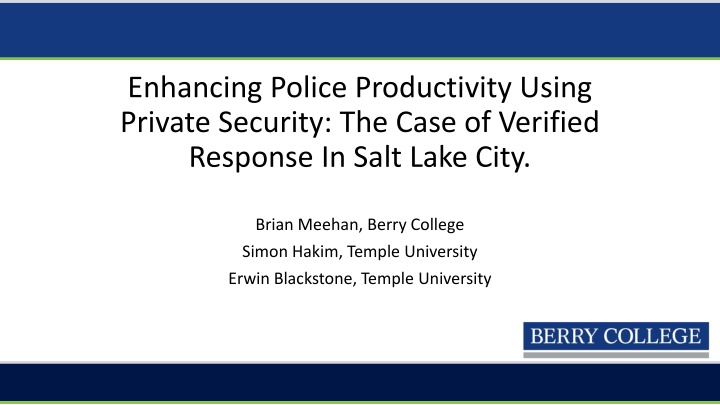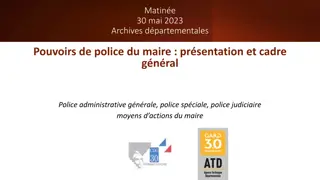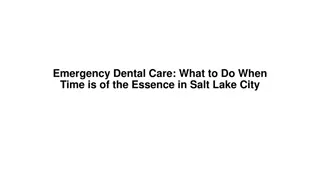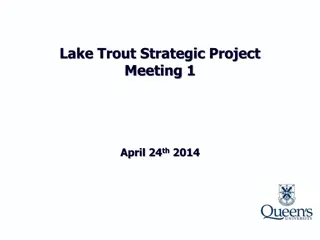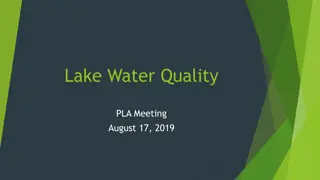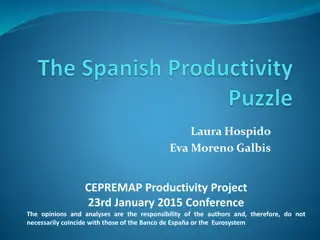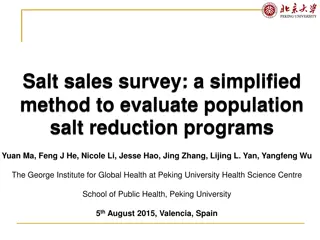Enhancing Police Productivity Through Verified Response in Salt Lake City
Addressing the issue of false burglar alarms draining police resources, this study proposes a Verified Response system in Salt Lake City. By requiring physical verification before police dispatch, this approach aims to optimize police productivity and reduce the strain caused by false alarms. The research explores the impact on police response times and efficiency, highlighting the potential benefits of this innovative solution.
Download Presentation

Please find below an Image/Link to download the presentation.
The content on the website is provided AS IS for your information and personal use only. It may not be sold, licensed, or shared on other websites without obtaining consent from the author.If you encounter any issues during the download, it is possible that the publisher has removed the file from their server.
You are allowed to download the files provided on this website for personal or commercial use, subject to the condition that they are used lawfully. All files are the property of their respective owners.
The content on the website is provided AS IS for your information and personal use only. It may not be sold, licensed, or shared on other websites without obtaining consent from the author.
E N D
Presentation Transcript
Enhancing Police Productivity Using Private Security: The Case of Verified Response In Salt Lake City. Brian Meehan, Berry College Simon Hakim, Temple University Erwin Blackstone, Temple University
The Problem of Police Burglar Alarm Response Police burglar alarm response is 94-99 percent to false alarms, resulting from users and technological errors. It is estimated that city police departments allocate 20-30 percent of their time to false alarm response. (Blackstone et al. 2005). This is a significant drain on public sector resources.
Alarm Response is a Quasi-Public Good Police response to a valid alarm, which results in arrest or apprehension, decreases the pool of potential burglars, reducing the probability of burglary or break in to the surrounding community. These spillover benefits from valid alarm response are somewhat non-excludable. But this is only 1-6 percent of alarm response!
False Alarm Response is a Private Good Response to a false alarm does not decease this pool of criminals, instead it allocates police resources away from potentially productive uses. False alarm response is a private good. Given that 94-99 percent of response is to false alarms we shouldn t treat alarm response as a pure public good.
Potential Policy Solution: Verified Response Salt Lake City ordinance put in place Dec. 2000. VR requires physical or visual verification of an actual or attempted penetration before police are dispatched. Thus, alarm owners designate individuals, including themselves, or private response companies to physically attend the premises, or using cameras and smartphones visually check the premises.
Police Alarm Response and Priority 1 and 2 Response Time 12250 14:24 VR Ordinance Dec. 2000 10250 12:00 8250 9:36 Alarm Responses 6250 7:12 4250 4:48 2250 2:24 250 0:00 1998 1999 2000 2001 2002 2003 2004 2005 2006 2007 2008 2009 2010 2011 2012 2013 2014 2015 2016 Year Police Responses Response time priority 1 Response Time Priority 2
Synthetic Control Comparison 10000 Total Police Alarm Response 8000 6000 4000 2000 0 2000 2005 2010 2015 year Salt Lake City Synthetic Salt Lake City
Synthetic Predictors Constructed from Donor Pool for Alarm Response Model Treated Synthetic Number of free police responses 4 3.529 Population 175901 176258.3 City Police Officers 404.33 405.191 Unemployment Rate 3.2667 3.927 Income Per Capita (2015 $) 37421.51 37415.42 2000 Alarm Responses 9439 9448.33 1998 Alarm Responses 10542 9837.8
City Weights From Donor Pool Used to Construct Alarm Response Synthetic Control City Weight used to construct Synthetic SLC Fayetteville, NC .216 Honolulu, HI .102 Asheville, NC .563 Leawood, KS .023 Orlando, FL .096 Evansville, IN 0 Irvine, CA 0 Greensboro, NC 0 Stockton, CA 0
Salt Lake City Burglaries, Alarm Permits, and Average Priority 1 Response Time VR Ordinance Dec. 2000 12:00 3000 10:48 2500 9:36 8:24 2000 7:12 Response time 6:00 1500 4:48 1000 3:36 2:24 500 1:12 0:00 0 1998 1999 2000 2001 2002 2003 2004 2005 2006 2007 2008 2009 2010 2011 2012 2013 2014 2015 2016 Year Response Time priority 1 Burglaries Permits
Synthetic Control Model for Burglaries 3000 2500 Burglaries 2000 1500 2000 2005 2010 2015 year Salt Lake City Synthetic Salt Lake City
Synthetic Predictors Constructed from Donor Pool for Burglary Model Treated Synthetic Number of free police responses 4 3.529 Population 175901 176258.3 City Police Officers 404.33 405.191 Unemployment Rate 3.2667 3.927 Income Per Capita (2015 $) 37421.51 37415.42 2000 Burglaries 2169 2172.342 1998 Burglaries 2831 2834.946
City Weights Used to Construct Burglary Synthetic Control City Weight used to construct Synthetic SLC Fayetteville, NC .017 Honolulu, HI .003 Asheville, NC 0 Leawood, KS 0 Orlando, FL .236 Evansville, IN .412 Irvine, CA 0 Greensboro, NC .061 Stockton, CA .272
False Alarms Per Patrol Officer and Priority 1 Response Time 50 14:24 VR Ordinance Dec. 2000 45 12:00 40 35 Alarm Responses per Patrol Officer 9:36 30 25 7:12 20 4:48 15 10 2:24 5 0 0:00 1996 1997 1998 1999 2000 2001 2002 2003 2004 2005 2006 2007 2008 2009 2010 2011 2012 2013 2014 2015 2016 Year False responses per patrol officer Response time priority 1
Abadie, A. Diamond, A., and Hainmueller. 2010. Synthetic Control Methods for Comparative Case Studies of Aggregate Interventions: Estimating the Effect of California s Tobacco Control Program. Journal of the American Statistical Association 105(400). 493-505
